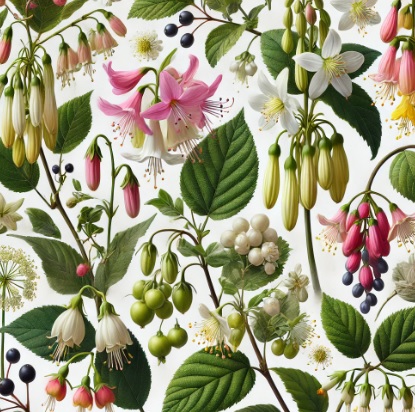The Caprifoliaceae family, commonly known as the honeysuckle family, is a group of flowering plants belonging to the order Dipsacales, consisting of around 15 genera and approximately 300 species. Many species within this family are woody plants, such as shrubs and climbers, and are widely distributed in temperate regions of the world. The honeysuckle (Lonicera) genus is the most well-known, famous for its fragrant flowers and climbing ability.
General Description
Plants in the Caprifoliaceae family share several common characteristics:
- Leaves: The leaves are generally opposite and simple, though some species may have alternate arrangements. They can have smooth or serrated edges and are sometimes covered with hairs or fuzz.
- Flowers: The flowers of Caprifoliaceae species are typically trumpet-shaped or funnel-shaped, with petals fused to form a tube. The flowers are usually small and fragrant, and they are arranged in clusters or terminal inflorescences. Flower colors vary, but many species are known for white, yellow, or pink flowers.
- Fruits: The fruits are typically fleshy berries, which can be red, blue, or black in color, containing many seeds. The fruits are often consumed by birds and contribute to seed dispersal.
- Stems and Roots: Many species of Caprifoliaceae are woody shrubs or climbing plants. Climbers, like honeysuckle, use their roots and stems to attach themselves to supports such as other plants or structures in order to grow upward.
Chemical Composition
The plants in the Caprifoliaceae family contain a variety of bioactive compounds, some of which have medicinal properties:
- Saponins: Some species of Caprifoliaceae, such as honeysuckle, contain saponins, which have anti-inflammatory and antimicrobial properties.
- Flavonoids: Flavonoids are present in many species of Caprifoliaceae and are known for their antioxidant, anti-inflammatory, and anticancer properties.
- Phenolic Acids: Some members of this family contain phenolic acids, which are known for their anti-inflammatory properties and ability to protect against free radical damage.
- Alkaloids: Some species of Caprifoliaceae may contain alkaloids that, while having therapeutic effects, can be toxic in high doses.
Physical Properties
The Caprifoliaceae family presents a range of distinctive physical traits:
- Fruits and Seeds: The fruits are generally fleshy berries, which can be red, blue, or black. The berries are rich in nutrients and are primarily consumed by birds.
- Leaves: The leaves are generally opposite and may be simple or serrated, with an arrangement that varies by species. The leaves are often green, but some species may turn darker or reddish in the fall.
- Flowers: The flowers are typically small and fragrant, and they appear in terminal clusters. They are known for their bright colors, which can range from white to yellow to pink or red.
- Stems: Many species of Caprifoliaceae are climbing plants, using roots and stems to attach to supports, while others are woody shrubs or bushes.
Production Process
Plants of the Caprifoliaceae family are cultivated for ornamental, medicinal, and sometimes culinary purposes:
- Honeysuckle (Lonicera spp.): Honeysuckle is widely cultivated for its fragrant flowers and its ability to cover fences, trellises, and walls. It is appreciated in gardening for its rapid growth and beauty.
- Sambucus (Elderberry) (Sambucus spp.): Elderberries are used to make jams, syrups, and beverages, and are used in folk medicine for their anti-inflammatory and antiviral properties.
- Weigela (Weigela spp.): This ornamental shrub is cultivated for its showy flowers and is used in gardens for its decorative beauty.
Applications
Medicinal
Many species in the Caprifoliaceae family are used in traditional medicine for their therapeutic properties:
- Honeysuckle (Lonicera spp.): Honeysuckle has antibacterial, antiviral, and anti-inflammatory properties. It is used in herbal medicine to treat colds, respiratory infections, and skin inflammations.
- Elderberry (Sambucus spp.): Elderberries are traditionally used to treat colds, flu, and other viral infections due to their antiviral and immune-boosting properties.
- Weigela (Weigela spp.): While primarily ornamental, some species of Weigela have been studied for their potential health benefits, including anti-inflammatory and antioxidant activity.
Culinary
Some members of the Caprifoliaceae family produce fruits that are used in cooking:
- Elderberries (Sambucus spp.): Elderberries are used in cooking to make jams, syrups, and beverages such as elderberry juice. They are also used in alcoholic preparations like liqueurs.
- Honeysuckle Flowers (Lonicera spp.): Although less common, honeysuckle flowers are sometimes used in certain cuisines for making infusions or as decorations.
Ornamental
Plants in the Caprifoliaceae family are often cultivated for ornamental purposes:
- Honeysuckle (Lonicera spp.): Honeysuckle is a popular climbing plant in gardening for its ability to cover walls, fences, and trellises with fragrant and colorful flowers.
- Elderberry (Sambucus spp.): Elderberry varieties, such as Sambucus nigra, are used for ornamental purposes in gardens due to their attractive flowers and berries.
Environmental
Plants in the Caprifoliaceae family also play an important role in the environment:
- Sustainability: Plants like honeysuckle and elderberry contribute to biodiversity and are important for providing habitats for birds and insects. Honeysuckle, in particular, is useful in stabilizing soils and promoting growth in challenging environments.
Environmental and Safety Considerations
While the Caprifoliaceae family offers numerous benefits, it is important to consider:
- Toxicity: Some species, like honeysuckle, can be toxic if consumed in large quantities, especially for children. The berries of certain Lonicera species contain compounds that can cause poisoning.
- Sustainability: The cultivation of ornamental and medicinal species in the Caprifoliaceae family must be managed carefully to avoid over-cultivation and preserve natural habitats.
INCI Functions
- Antioxidant: Protects the skin from oxidative damage.
- Anti-inflammatory: Reduces inflammation and soothes the skin.
- Antimicrobial: Helps combat harmful microorganisms on the skin.
- Moisturizing: Helps hydrate and retain moisture in the skin.
Conclusion
The Caprifoliaceae family is an important group of plants that provides numerous benefits for medicinal, ornamental, and even culinary purposes. Species such as Lonicera (honeysuckle), Sambucus (elderberry), and Weigela are widely cultivated for their therapeutic properties, ornamental value, and, in some cases, culinary uses.
![]() Caprifoliaceae
Caprifoliaceae 

